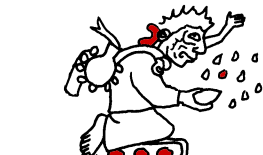Also visit the DePaul Art Department Site
Art 102: Principles of Art History
Course Description:
This course is designed to introduce students to some of the monuments and ideas that characterize a basic history of art, from the Ancient Egyptian period through the 20th century. In this class, selected art objects-including paintings, sculptures and architectural forms-are interpreted in conjunction with cultural history, as discussions relate the style of a given work to the particular social, political, and economic environment in which it originally functioned. In lecture, selected monuments are used to demonstrate certain fundamental topics in the discipline, particularly the use of visual expression across time as an instrument through which to manipulate viewer opinion. While the course mostly surveys artistic developments in the Western world, there will also be a special section on non-Western (especially Latin American) art objects and related issues.
ART 202: Art of Latin America
Course Description:
This course offers an overview of the principal developments in the history of Latin American art, from prehistoric times to the modern period. Art will be surveyed contextually as artistic traditions are considered in light of major historical changes and continuities in the cultural landscape of Latin America. Lectures and discussions explore both some dominant themes that unify art produced in this part of the world, as well as the diverse cultural characteristics that have given rise to regional styles. The class will view pre-Columbian, colonial, and modern Latin American art from critical perspectives, with topics including the diversity of indigenous traditions, colonialism and the clash of Spanish and native forms, problems in race and gender, and the relationship of later Mexican, Central American and South American art to European Modernism. The related issues of the invention and appropriation of visual forms will together provide an overarching framework for the interpretation of art across time in Latin America.
Art 243/LST 300: Principles of Latin American Art
Course Description:
What is distinctive about art created over time in the area now known as Latin America? This class begins to answer the question by critically examining some of the principal developments in the history of art especially from Mexico, but also from other places in Central and South America. Lectures will present material chronologically, starting with ancient cultures (like the Olmec and Moche) up through the early modern period (to Independence from Spain, in the early 19th century), but will also be issue-oriented. In other words, we will NOT survey all of Latin American art history nor make any attempt to cover all aspects of cultural production. Rather, we will focus on selected ideas and problems facing scholars in their study of literally thousands of years of art from this region. Periodic discussion sessions will allow the student to weigh in on particular issues and offer their own critiques. This class will argue that the distinctiveness of visual forms in Latin America springs from the heterogeneous cultural traditions that frequently divide and also often unify people of the region.
Art 397: Colonial Mexican Art
Course Description:
The fall of the Aztec Empire to Spanish domination in 1521 is arguably the most formative event in Mexican history, as it initiated an intense period during which European and indigenous American people and cultures were forced to face and make sense of each other. This art history seminar analyzes art and architecture created in the wake of that turbulent confrontation, to reveal a delicate process of cultural integration and negotiation that characterizes Mexico's early colonial period. Readings will focus on critical issues like the introduction of Christian imagery to local audiences, the role of indigenous artists and patrons in art production, and the use of terminology like 'syncretism' (the union of opposing concepts and symbols) in the discussion of sixteenth-century Mexican visual culture, in particular. This course argues that a proper understanding art of this period requires a careful consideration of its culturally mixed social environment.
ISP 101-313: The Virgin of Guadalupe in History and Image
Course Description:
The goddess at the heart of modern Mexican nationalism today is an almost omnipresent symbol with multiple layers of meaning. This class takes as its focus the topic of the Virgin of Guadalupe, especially as her image developed during the colonial history of Mexico. Explorations of the Virgin's early significance will be grounded first in a solid understanding of the historical and art historical context in which she first appeared. Readings and discussions will then consider various aspects of the emerging cult, including sources for the original legend, issues of syncretism, and aspects of Marian iconography celebrated in early depictions of Guadalupe. Ultimately, through readings and discussions, this class proposes that the Virgin of Guadalupe has been a forceful symbol of shifting powers over time.
|


